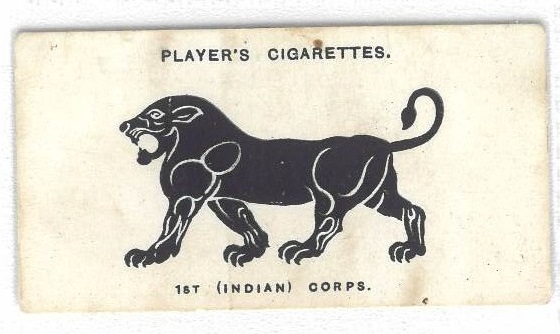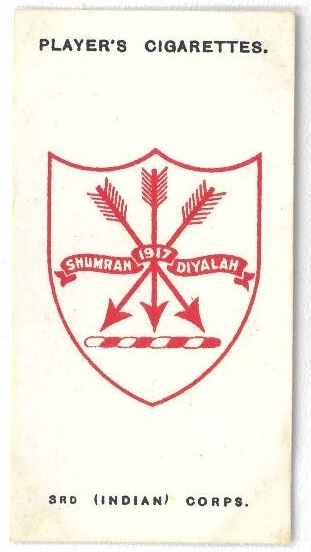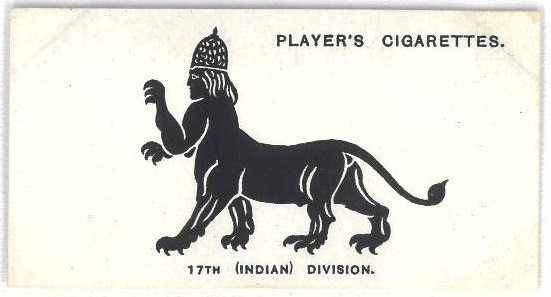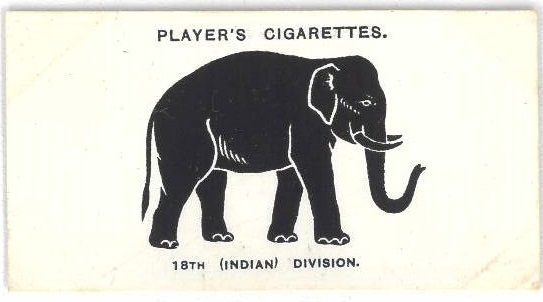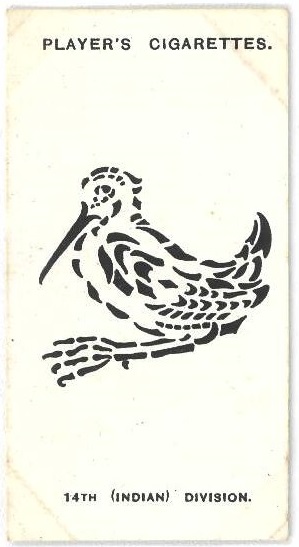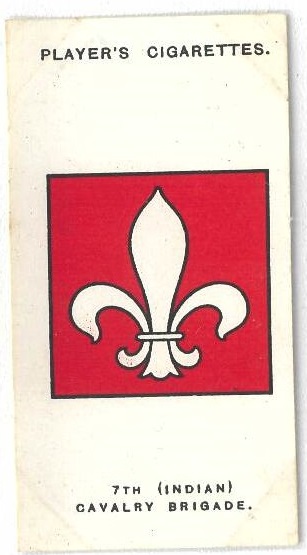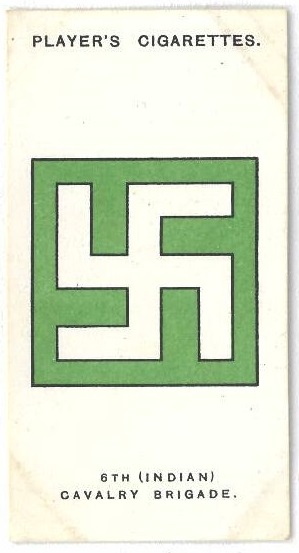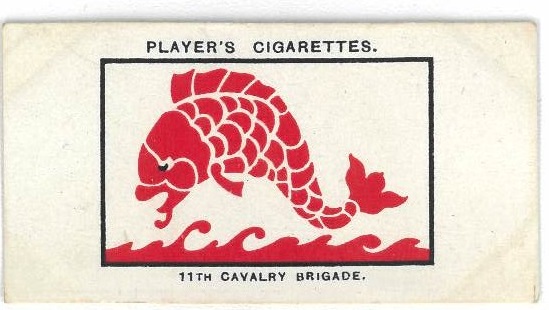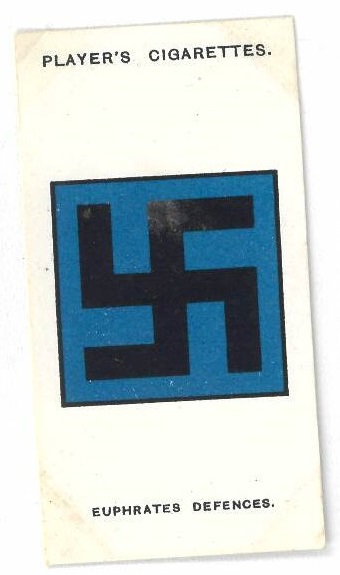No 101- 1st (Indian) Corps
This corps was known as the Indian Corps during its service on the Western Front until the end of 1915; from thence it went to Mesopotamia, where, known as the “Tigris” Corps it took part in the attempt to relieve Kut. It was then composed of the 3rd and 7th Indian Divisions. Later on it was renamed the 1st (Indian) Corps, and the 17th and 18th Indian Divisions replaced the 3rd and 7th. The Corps- under the command of Lieut.-General A.S. Cobbe, VC, KCB, KCSI, DSO- was in the operations which took place on the Tigris up to Mosul, and finally ceased to exist in March 1919.
No 102- 3rd (Indian) Corps
Like that of the 9th Corps, this sign was founded on the crest of the Corps Commander, Lieut. General Sir Raleigh Egerton, KCB, KCIE. TYhe Egerton crest is three arrows as in the sign, but of gold with black points and feathers tied with a red ribbon. The arrows in the sign were shown in red (the three being symbolical of the Corps’ number), and on the ribbon were two of the battle honours of the Corps during its fighting in Mesopotamia- “Shumran” and “Diyalah” (the crossing of the Diyalah River a few miles below Baghdad by the 13th Division in March 1917)
No 103- 17th (Indian) Division
The quaint device used as a sign by this division is an adaptation of the Assyrian Man Lion of Babylonian times. The division was commanded by Major-General G.A.G. Leslie CB and was formed in Mesopotamia in October 1917. It served in that theatre of war until the Armistice, where, with the 18th (Indian) Division it composed the First Indian Corps.
No 104- 18th (Indian) Division
This division was concentrated near Baghdad in December 1917. Its artillery (336th and 337th Brigades, R.F.A.) came from England, its Machine Gun Company (the 249th) from Flanders and its infantry (53rd, 54th and 55th Brigades) from India. It was commanded by Maj.-Gen Sir H.D. Fanshawe, KCMG, CB and formed part of the First Indian Corps. The sign of the elephant was taken from the badge of the 19th Hussars, to which the General belonged. All its active service was in Mesopotamia on the Euphrates and Tigris Front. It blockaded Nejef after the murder of the Assistant Political Officer, Captain Marshall, and finally occupied Mosul.
No 105- 14th (Indian) Division
This division was under the command of Major-General Sir Theodore Fraser KCB, KCSI, CMG and was formed in May 1916. All its service was on the Tigris front in Mesopotamia, where it formed part of the Third Indian Corps. One of its chief achievements was the crossing of the Tigris at Shumran Bend in February 1917, which led to the withdrawal of the Turks from Sunniyat and Kut and eventually from Baghdad. The sign was a woodcock, that bird being common in the are occupied by the Division when on the Diyalah River, some sixty miles NE of Baghdad.
No 106- 13th (Indian) Division
The five-pointed star of this division represents the star of India. It was used chiefly on account of its simplicity. The division, commanded by Major-General Sir H T Brooking KCB, KCSI, KCMG was formed in May 1916 at Nasiriyeh on the Euphrates- within ten miles of Ur of the Chaldees, whence Abraham came (hence the division’s fitting comment on the sign “quite suitable, for we rose in the east”)- at the same time as the other indian Division in the Third Indian Corps, the 14th. The third division in this corps was British, the 13th (Western). All the war service of the 15th Indian Division was in Mesopotamia on the Tigris Front.
No 107- 7th (Indian) Cavalry Brigade
The fleur-de-lis sign of this brigade had no particular history. It was used on account of its simplicity and the fact that the fleur-de-lis was one of the charges in the coat of arms of its commander- Brigadier General CEG Norton, CB, CSI- had no bearing on its adoption. The brigade served originally in France, and went out to Mesopotamia early in 1916, remaining there until the end of the war when it was at Mosul. It was composed of the following units- “V” Battery RHA, 13th Hussars, 13th D.C.O. Lancers, 14th Jat Lancers, 16th Machine Gun Squadron and 7th Field Troop R.E.
No 108- 6th (Indian) Cavalry Brigade
This brigade used as its sign the swastika- the emblem representing the sun which was used by the early Aryan peoples. The same sign was also used by the Euphrates Defences, but the latter had it in black on a blue ground. The 6th (Indian) Cavalry Brigade was serving on the Mesopotamian Front at the finish of the war, where it was commanded by Brigadier-General P Holland Pryor, CB, CMG, DSO, MVO.
No 109- 11th (Indian) Cavalry Brigade
This brigade was formed in 1917 and served from then until the end of the War on the Mesopotamian Front. The Armistice found it in Mosul. It was commanded by General RE Cassels, CB, CSI, DSO, and the red dolphin was copied from the Cassels Crest, “a dolphin naiant embowed or.”. The brigade was composed of “W” battery RHA, 7t Hussars, Guides Cavalry Frontier Force, 23rd Cavalry Frontier Force, 25th Machine Gun Squadron and 5th Field Troop, Sappers and Miners.
No 110- The Euphrates Defences
The sign used by the Euphrates Defences was a swastika, a symbol intended to represent the sun, and used by the early races if Aryan stock. The Euphrates Defences were in existence from August 1916 to December 1918 and were commanded during the whole period by Brigadier General FRE Lock DSO. The command was constituted of a combined force of all arms and included armoured trains and gunboats. The limit of the area of command were from the Shinefiyah Lake on the north to Fao on the Persian Gulf, and also included the Karun River up to Ahwaz.
